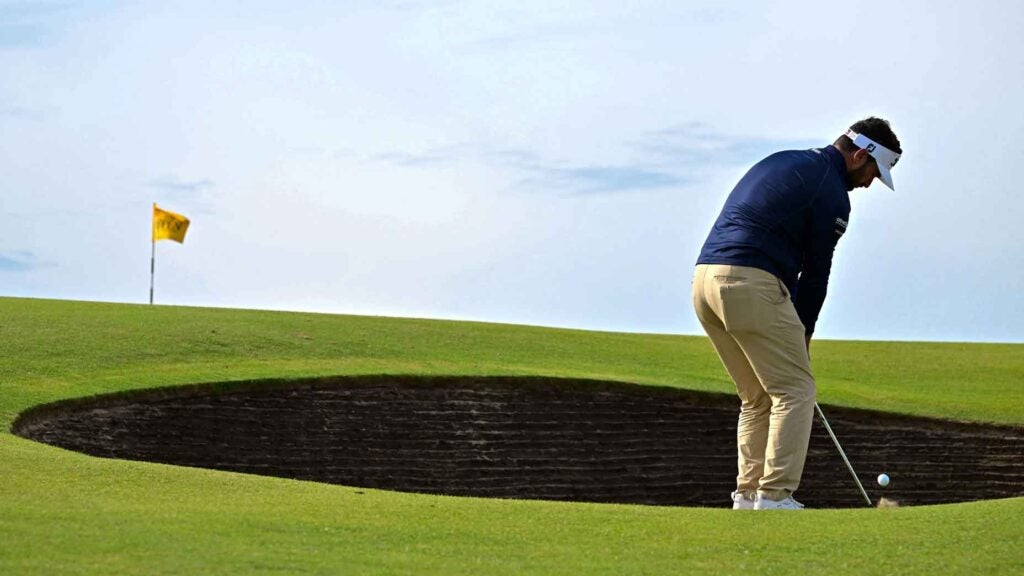Having the right touch on a pitch shot is already tricky for many amateurs, but when you add in an extra hurdle like a bunker to clear, it can be downright intimidating.
I’m here to remind you that you can have success with this difficult shot, though, so long as you have the right principles and game plan.
The ability to pitch the ball is a necessary skill that requires great technique and practice. So take a look below at my 10 ways you can gain the confidence you need to pitch over bunkers to save yourself strokes.
1. Choose the right club
When hitting a true pitch shot — where you need to get the ball into the air to carry something of consequence like a bunker or long grass — you want the ball to roll the least amount possible. For this reason, you should choose a club with a high amount of loft and bounce.
The three clubs you can consider when hitting a pitch shot are a lob wedge (60 degrees), sand wedge (56 degrees), and gap wedge (50-52 degrees).
The loft helps with launch, and the bounce will allow the club to glide along the ground rather than dig. This is a perfect combination for hitting over a bunker and getting the ball to sit quickly upon landing.
2. Use the club’s bounce
As mentioned above, using the bounce of the club will help you hit the ground before the ball (or underneath the ball), while still allowing the ball to get into the air and over the bunker.
Many golfers know the word bounce, but they don’t truly understand it’s role.
When used properly, the bounce of the club can act as insurance against digging into the ground — which is important to generate loft. This high bounce wedge from Miura is a great club option.
3. Club at address
In order for the loft and bounce to work properly, you want to avoid excessive angles at address and impact — so setting up properly is an important first step.
Have the end of the club pointing towards the center of your body and do not lean it forward. Ideally, the handle of your club will point relatively in line with your belly button.
4. Club at impact
At impact, the club shaft will ideally be straight up and down, or even leaning back and away from the target. This allows both the loft and the bounce to be used appropriately.
Be sure to release the clubhead, allowing it to swing as if your trail hand is making a smooth slapping motion at the bottom. Doing this will help you avoid any excessive shaft lean.
5. Determining if you should open the face
Opening the clubface can be useful on pitch shots, but if you’re already using a club with the correct amount of loft for you, you may not need to.
If you tend to have high clubhead speed, you may want to consider opening the face; which will help produce more launch. But for most amateur players, simply using the loft of the club is enough to hit this shot effectively.
6. Hit the ground
To properly launch a pitch shot, the club needs to hit the ground and make a “thump” noise. If you just barely brush the top of the grass, it won’t provide enough power to lift the golf ball in order to clear the bunker.
Before addressing your ball, take practice swings that mimic your real shot, allowing the bottom of your club to make firm contact with the ground.
7. Your swing size controls the distance
What makes this type of pitch shot so difficult is understanding how to control your distance.
Not only do you need to carry the bunker and try to land the ball in a smaller area, but you need to make sure the ball stays on the green within a reasonable distance for your putt.
So make sure to dial in the size of your backswing, which will help control the distance that the ball travels in the air.
8. Setup helps control swing size
Your setup should match your desired swing size.
The smaller the setup, the easier it is to make a smaller swing. The larger the setup, the more natural it is to make a larger swing.
For a smaller setup, grip lower on the club and narrow your stance. This will help limit the length of the lever (your backswing), helping you avoid making too big of a swing.
9. Have a pre-shot routine
You should always have a pre-shot routine, so hitting this type of pitch shot is no different.
Not only do you need to set your club properly and use good posture, but you need to hit the ground and manage both the setup and swing size. When taking your practice swings, you’ll ideally incorporate each of these tasks, which will provide the feel you need to execute this shot.
10. It’s better to be longer than shorter
It’s quite simple, really: If you’re short, you’ll likely be in the bunker.
Your first objective on this shot is to clear that hurdle, so when practicing, a simple goal should be to plan to miss more long than short. By thinking this way, it should lead to a large enough swing to comfortably clear the sand.
The Divot Board – Patented Low Point & Swing Path Trainer
View Product

